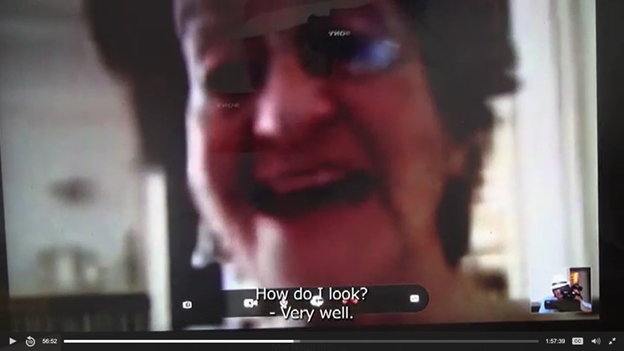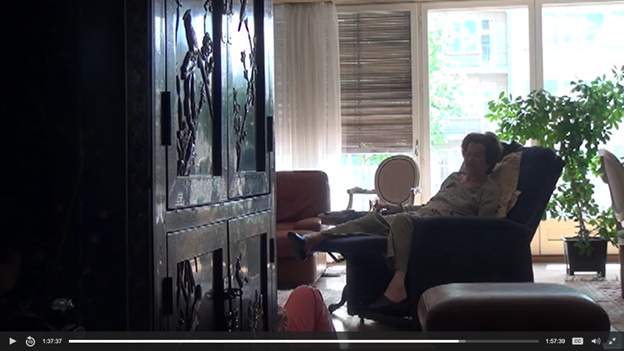Is it possible people come to us—I do not here aspire exactly to a metaphysical argument, and certainly not one about faith or god, but rather just a simple, spiritual question—and then go away from us?
— Ross Gay, THE BOOK OF DELIGHTS
Not laid side to side nor end to end but like a series of covered archways and domes over a corridor,[i] in a way similar to how letters combine together to make up words we use to make phrases, our intentions build our moments. Our minds propel and pull, project from our bodies our behaviors. Our corpus draws the creation of our experience with our attention and builds upon many things put together, upon the layers of our prioritizations. C stands for our life’s constitution—for the configuration in the ABCs of our life’s composition.
Relational beings, we use words and images to communicate our beings with each other. C is for communication, for conversing. Like so many films, No Home Movie asks us to reflect on our relating from ourselves to others and vice versa and from our self back to ourselves. We hardly see director Chantal Akerman interviewing her mother. She is recording this from her perspective for us to see as she sees, for her to view herself later, the way she views. It’s almost as though in this period of her life, Akerman was aware she was preoccupied, maybe not fully there in mind, thinking perhaps of her classes to teach or fragmented in other ways, not able to fully receive, absorb, reflect the love her mother had for her. No Home Movie is like a meditation Akerman engaged in for herself that she decided to share. Wanting to be able to return and document these final love notes, love images she recorded her mother sending to her in person and over Zoom, questions for me seem to bubble up and percolate: how do I engage with my mother, how does she engage with me?
These conversations Akerman kept and captured to keep alive—she wanted to keep communicating. She wanted to be able to watch at some point later her mother loving her again, her mother saying goodbye to her and the world, but also watch herself absorbing that love, really hearing that goodbye, maybe where she wasn’t able to as fully in that particular time. C is for communication, for conversing.
Writer Trinh T. Minh-ha’s work yields points particularly relevant, her metaphor of a set of mirrors reflecting ourselves endlessly back to ourselves, insightful. We reflect off a mirror with or without our active attention. Forgetting the instrument, absorbing our attention on the reflection, the sense of an object looking at subject can disappear, object or subject or neither can remain.
Because we change as our attention changes, what we think about our reflection can change that reflecting. Parts of ourselves dissolve in these moments, looking at ourselves looking. We can observe ourselves creating and change not just what’s created, as a result, but how we create. We can look at the mechanism that places words together, look at ourselves at the moments of creation, at the beginnings of the impulse(s) of our languaging and “metaphors we live by.”[ii] In some way perhaps when reflecting on writing, by writing, the instrument of writing can dissolve and only our “reflection,” our internal mechanism for the putting of the words together, remains.
I haven’t seen [it]and yet, at the same time, I have seen it. I’ve seen it because someone showed it to me—with words.[iii]
Out to go in, in to go out. Sometimes there is no longer someone creating. There is only creating and the roots of life branching out. Outer and inner dissolve, the mechanisms for creating observed. Only our creativity, creation, is present. In these moments I’ve become a tree or a current of water or a star spraying dust, or rather, I’ve gone into the neurolingual chemical circuitry of my body’s being. These paths—reflecting in a mirror, reflecting on writing, reflecting on film, any number of paths that boil down ultimately to reflecting on my actions day to day, moment to moment—can lead me back into the source(s) of my creation. C is for combustion and the chemical circuitries of creating.[iv]
C is also for the chair the mother in No Home Movie reclines in, extremely fatigued all the time. Although she loves to talk to Akerman, her daughter she normally can’t be with enough, most all she can do now when she visits is rest, reminding me of my grandmother’s last few months.
My grandmother was always so tired. It became such extraordinary labor just for her to be awake. As in Maggie Nelson’s piece, my grandmother’s skin, if memory serves me, seemed to become ever more blue tinged, even with hues of purple as though the veins were changing composition and their color taking over the body. The capacity of her flesh and her skin “to emit, reflect, absorb, transmit, or scatter light” was changing drastically.
My Dad, Aunt, and cousin like to argue and around my grandmother’s bed just minutes before she passed were having at it over who knows what. Suddenly, I can remember the room grew extremely warm, familiar, loving, and cozy. Everyone loved each other and were happy to be together. Someone remembered to check my grandma. Somehow in her passing on she had blessed the room and us with a bubble-loving kind, blanketing, warmth. There seemed to be no other explanation for the sudden change of feeling in the room. “Her capacity to emit, reflect, absorb, transmit, or scatter light” had changed yet again for that moment. What is the composition, the color, of a blessing or of feeling blessed in this moment?
D is for death and departure, for dying and decomposition. Everything put together will fall apart. Everything composed, the Buddhists say, shall be decomposed. No Home Movie is about separating from the body. Trying to catch her mother and her stories and her way of being before she passes on. Akerman and her mother have wanted to be with each other more than they could and it always seems like not enough time they get to spend together. Trying to hold and hang onto her mother, she records her to be able to memorialize and reveal her to herself and us later on.
Long shots of the outside panorama while driving, of spaces inside, depict a certain changing relationship to the passing of time, a beginning to observe life and the body, one’s memories and one’s present from a differing vantage point as the body begins its final shutting-down processes. D is also for descension. Interestingly in some ways as the body begins its ultimate descent, the mind or soul may begin conversely opening up. Many telling of near death experiences describe an open vista, bright and beautiful, loving, where the chains of the mind have been let go of. The long shot of the grassy meadow blowing gently in a warm wind under blue sky Akerman adds, after cutting from her mother’s lying in her chair, indicates this departure and contrasting opening or ascension.
E is for extract. Akerman tries to extract all the more from her mother, more stories, more liveliness, more sociability, more conversation. But her mother is withdrawing. There are limited shards of conversation to extract. It’s mostly a resting period. Somehow though saying very little they have become even closer. E is for even closer. The frame acts as a container for increased intimacy. We see the lovely change in lighting, the passage of time through the day, as the dark shadows take over the room with the reclining chair her mother rests in. Rest, everything is rest. From rest comes energy and from rest comes life, and from rest goes life as well. Life Leaves—the Great Departure (or Arriving) —leaves leave, leaves of life leave, leaving leaves—and all that remains is a bunch of mulch, living compost: the dirt is alive. E is for energy for everything comes from rest.
F stands for frames. Frames depend on context, on relationing. In relation to G, F comes before G and G is for saying goodbye. “[I would like to say even more about how beautiful I think you are, but when I know others will hear it, I stop],” the mother tells the filmmaker directly over Zoom into the camera as though my own mother or grandmother were telling me directly how much she loves me; a most touching homage of sorts to her by capturing her sweet expressions of love for her daughter. We watch her mother with her—at times we watch Akerman watch her mother (maybe prompting us to watch ourselves more in our life as a reflection on where we place our attention, watching ourselves watching) as her mother begins to say goodbye to the world, to her, to her home she’s lived in for so long, to her body. What a beautiful way to leave, to live, to love—to float away. F floats and flies and finds away.
Can I love more now? If I must die too, can I love these moments of life more—can I feel more love in this moment? How, how, how? H is for how and F is for feel. How might I trigger my feeling of more love? Remembering her mother’s face in the Zoom image turning to listen better, “You know I don’t want to bug you. The last thing I want is to bug you… I wish you all the best.”
Author Biography
My name is Victor Bowman-Rivera and I’ll be a second-semester senior at Amherst College, spring 2022. Mostly I’m interested (or at least, I believe I should mostly be) in energy healing and meditation: in how our minds can make us feel better and bring kinder experiences and outlooks, nourishing, into the world. I’m learning to be friendlier—how to be a better friend, maybe even one day a good one.
[i] Trinh, Minh-ha. Woman, Native, Other: Writing Postcoloniality and Feminism. Indiana University Press, 1989, p. 20.
[ii] See George Lakoff and Marc Johnsen’s Metaphors We Live By for more on how we don’t actually think logically, but rather in metaphors, images, and “frames.” How we frame any of the aspects in our experience changes our relationship and feeling toward them and can affect how we feel about other aspects as well. Example: when subjects were asked to remember a moment of belonging and acceptance they reported the room felt warmer than when asked to remember moments when snubbed or rejected
[iii] Daney, Serge. Postcards from the Cinema. Translated by Ann Goldstein. Berg, 2007, p. 4.
[iv] Bahiya Sutta, Udana 1.10, “Train yourself like this,” Buddha said, “whenever you see a form, simply see; whenever you hear a sound, simply hear; whenever you smell an aroma, simply smell; whenever you taste a flavor, simply taste; whenever you feel a sensation, simply feel; whenever a thought arises, let it be just a thought. ‘You’ then will not exist; whenever you do not exist, you will not be found in this world, another world, or in between. That is the end of suffering.”






































